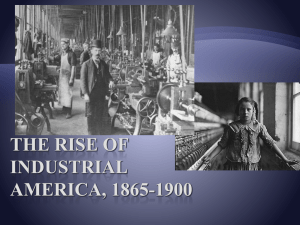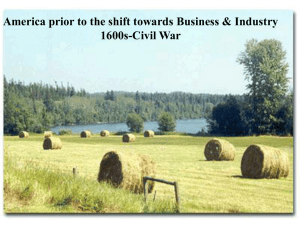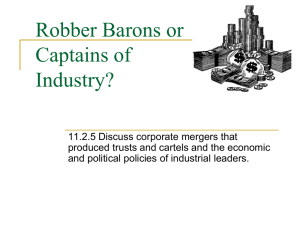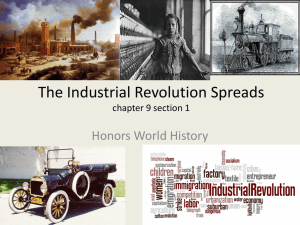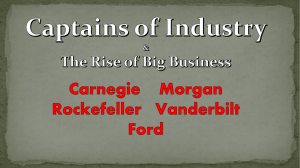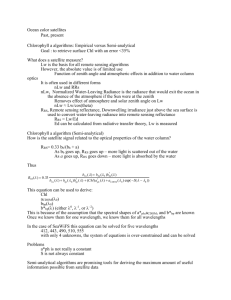The Rise of Industrial America, 1865-1900
advertisement
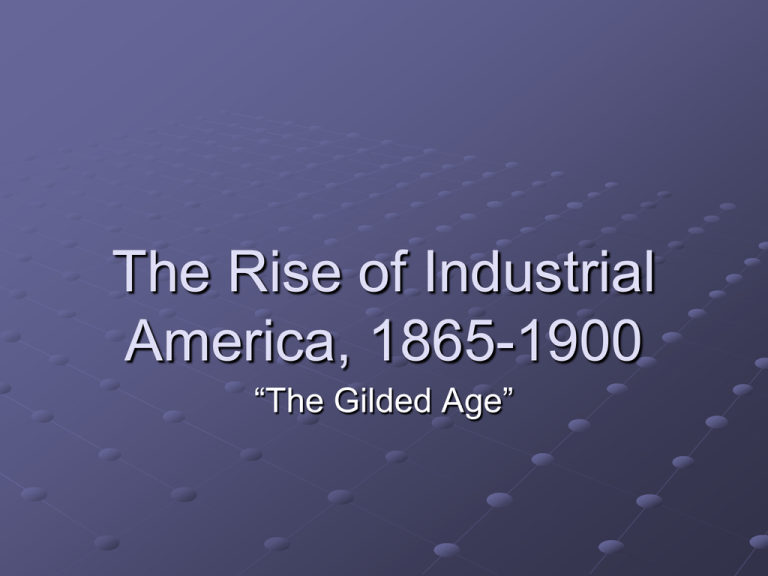
The Rise of Industrial America, 1865-1900 “The Gilded Age” President Grover Cleveland, 1888 As we view the achievements of aggregated capital, we discover the existence of trusts, combination and monopolies, while the citizen is struggling far in the rear or is trampled to death beneath an iron heel. Corporations, which should be the carefully restrained creatures of the law and servants of the people, are fast becoming the people’s masters. 1900: U.S. led the world in industry Natural resources: coal, iron ore, copper, lead, timber, and oil Labor supply: hundreds of thousands of immigrants between 1860 and 1900 Growing population Advanced transportation network Capital was plentiful: even Europeans invested in the U.S. Development of laborsaving technologies Over 440,000 new patents between 1860 and 1900 Laws protected private property Subsidized RRs with land grants and loans Protective tariffs Little regulation on business Few taxes on corporate profits Entrepreneurship The Railroads RR mileage increased more than 5x from 1865 to 1900 Nationwide RR network created a market for goods Encouraged mass production, mass consumption, and economic specialization Promoted growth of coal and steel industries Divided into 4 time zones in 1883 Modern stockholder corporation Development of structures in finance, business management, and regulation of competition Eastern Trunk Lines Major route between large cities Cornelius Vanderbilt used steamboat profits to merge local RRs into the New York Central Railroad in 1867 (NY to Chicago) Baltimore and Ohio RR Pennsylvania RR Western Railroads Coincided with settlement of the last frontier Promoted settlement on the Great Plains Linked the West with the East Federal Land Grants 80 RR companies received more than 170 million acres of public land Gov’t expected them to sell land around RR routes in order to finance construction Negative Consequences Quick and poor construction Corruption in government Credit Mobilier Scandal RRs controlled half of the land in some western states Transcontinental Railroads Congress authorized The Union Pacific and the Central Pacific to build during the Civil War Union Pacific Across Great Plains, starting in Omaha, NE War veterans and Irish immigrants Central Pacific Through Sierras from Sacramento 6,000 Chinese immigrants Came together May 10, 1869 at Promontory Point, UT (Golden Spike) By 1900, 4 more transcontinental RRs existed James Hill’s Great Northern was the only one built without subsidies Competition and Consolidation RRs were overbuilt and some were unprofitable Mismanagement and fraud Speculators (Jay Gould) made quick profits by selling off assets and watering stock: inflating value of assets and profits before selling to public Offered rebates and kickbacks to favored shippers Farmers often had to pay higher prices Pools: competing companies agreed secretly to fix prices and share business Panic of 1893 Forced ¼ of RRs into bankruptcy J. Pierpont Morgan and other bankers took control and consolidated RRs Stabilized rates and reduced debts By 1900, 7 giant systems controlled 2/3 of the RRs Interlocking directorates: same directors ran competing companies creating regional RR monopolies William Vanderbilt: “The public be damned.” Granger Laws overturned by courts Industrial Empires Shift in industrial production in the late 19th century Early factories had produced textiles, clothing, and leather products “Second Industrial Revolution” after the Civil War Heavy industry: steel, petroleum, electric power, and industrial machinery The Steel Industry Henry Bessemer in England and William Kelly of the U.S. discovered an new process of making large quantities of steel: “The Bessemer Process” Great Lakes Region became leading steel producer Andrew Carnegie Poor Scottish immigrant who became the superintendent of a PA RR. 1870s: started manufacturing steel in Pittsburgh Vertical integration: company controls every stage of the industrial process Mining raw materials to transporting the finished product Carnegie Steel was at top by 1900 U.S. Steel Corporation Carnegie wished to retire and devote himself to philanthropy Sold company to J.P. Morgan for over $400 million First billion-dollar company Largest enterprise in the world 168,000 employees Controlled over 3/5 of the nation’s steel business The Oil Industry 1st U.S. oil well drilled by Edwin Drake in 1859 in PA Rockefeller and Standard Oil Applied latest technologies and more efficient practices Rebates from RR companies and temporarily cut prices to eliminate competition (“one-two punch”) Controlled 90% of the oil refinery business by 1881 Formed a “trust”: horizontal integration Other industries copied and organized trusts Antitrust Movement Sherman Antitrust Act (1890): prohibited any “contract, combination, in the form of trust or otherwise, or conspiracy in restrain of trade or commerce.” Too vague to be enforced United States v. E.C. Knight Co. (1895) ruled that the law could only be applied to commerce, not manufacturing Few convictions until the Progressive Era Laissez-Faire Capitalism The government should stay out of the economy The government should not regulate businesses Conservative Economic Theories The Wealth of Nations (1776): economist Adam Smith argued that business should not be regulated, but supply and demand should be the determining economic forces American industrialists used laissez-faire economics to justify their business practices Social Darwinism Theory of natural selection English social philosopher Herbert Spencer believed that the theory should be applied to the marketplace The concentration of wealth should be held by the “fit.” Professor William Graham Sumner of Yale argued that help for the poor would interfere with the laws of nature Gospel of Wealth Used religion to justify wealth J.D. Rockefeller applied the Protestant work ethic: hard work and success are signs of God’s favor Carnegie’s article “wealth” argued that the wealthy had a God-given responsibility to carry out acts of civic philanthropy Technology and Innovations Inventions Telegraph by Samuel Morse Improved transatlantic cable (1866) Telephone by Alexander Graham Bell (1876) Typewriter (1867) Cash register (1879) Calculating machine (1887) Adding machine (1888) Kodak camera by George Eastman Fountain pen Gillette’s safety razor Edison and Westinghouse Thomas Edison “Invention Factory” More than 1000 patents Phonograph Incandescent lamp Mimeograph Motion picture machine George Westinghouse More than 400 patents Air brake for the railroads Transformer for electrical current Made possible lighting for cities and operation of streetcars, subways, and appliances Marketing Consumer Goods R.H. Macy in NYC Marshall Field in Chicago Frank Woolworth’s Five and Ten Cent Stores Sears Roebuck and Montgomery Ward provided for catalog orders Packaged foods: Kellogg and Post Refrigerated railroad cars and canning changed the war Americans ate Created a consumer culture Impact of Industrialization Raised the standard of living for most people Created sharper economic and class divisions among the rich, middle class, and the poor Concentration of Wealth By the 1890s, the richest 10% controlled 9/10 of the nation’s wealth. New class of wealth Newport, RI “cottages” Horatio Alger myth Author’s novels sold more than a million copies Portrayed a young man who became rich and successful through honesty, hard work, and a little luck In reality, few experienced this rags-to-riches story Typical wealthy business person was a white, Anglo-Saxon, Protestant male who came from an upper or middle-class background Expanding Middle Class Growth of corporations provided a need for white-collar workers Middle management was needed Expanded middle class through creating jobs for accountants, clerical workers, and salespersons Wage Earners By 1900, 2/3 worked for wages that required them to work ten hours a day, six days a week Determined by supply and demand Factory wages were barely above subsistence Real wages rose steadily, but most families still could not support a family on one income Women and children were working to make up the difference 1890: 11 million of the 12.45 million families averaged less than $380 a year Working Women 1 out of every 5 women were working in 1900 Most were young and single Women usually worked in textile, garment, and food-processing industries Secretaries, bookkeepers, typists, and telephone operators Labor Discontent Assigned one step in the production; monotonous Exposed to chemicals and pollutants Changed jobs on average every 3 years Many joined unions Struggle of Organized Labor Industrial Warfare Businesses held most of power because of the surplus of cheap labor Lockout Blacklists Yellow-dog contracts Private guards and state militia Court injunctions Great railroad strike of 1877 Hayes used federal troops to end labor violence Attempts to Organize National Unions National Labor Union Attempt to organize all workers skilled and unskilled Knights of Labor Began secretly by Terrence Powderly Opened membership to all, including women and AfricanAmericans Worker cooperatives Abolition of child labor Abolition of trusts and monopolies Wanted to arbitrate rather than strike Haymarket bombing American Federation of Labor Samuel Gompers Higher wages and improved working conditions Strikebreaking Homestead Strike Failure set back the union movement in the steel industry until the New Deal Pullman Strike Federal court issued an injunction forbidding interference and ordering workers to abandon the strike Eugene Debs (American Railway Union) and other union leaders were arrested and jailed.
